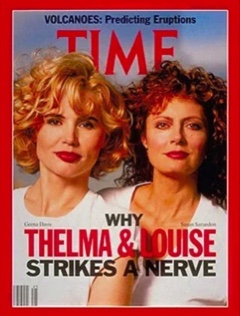Thelma and Louise: A Film Reflective of its Time

The 1991 hit American drama, Thelma and Louise, challenges the barriers that traditionally divide the depiction of men from women in film. Thelma and Louise, two women whose lives are personally and professionally dominated by men, decide to embark upon an adventure that goes awry and they find themselves becoming outlaws on the run. The manipulation of light and shadows as well as the variation of the musical score throughout the film help to reinforce the distinction between confinement versus freedom and patriarchal dominance versus female empowerment – ultimately reflecting the change in the role of women in the 1990s.
There is a clear spectrum with regard to light and sound in Thelma and Louise. The film opens with both characters occupying dark and confining spaces. Thelma is in a dimly lit and cluttered home kitchen, while Louise is working as a waitress in a dark and cramped diner kitchen. Interestingly, both women are relegated to the kitchen – women’s traditional domain of domesticity. As the film progresses, light creeps into the frame as Thelma and Louise abandon these confined spaces. In addition to the disappearance of darkness, the music shifts to a more uplifting and liberating tone as they escape the suffocation of their lives. The viewer becomes fully engrossed visually and auditorily as light and sound propel the film along the continuum toward rebellion against the male-dominated framework.
Thelma and Louise is not only intended for entertainment, but is certainly reflective of the era in which it was made. By the 1990s in America, the role of women in society began to shift. The average age of marriage rose from early to mid-20s and women began to pursue independent academic interests and careers over domestic duties. Women questioned the sexual division of labor and empowered one another to become high-achievers in the workforce. By choosing to escape abusive relationships and lives of limited potential, Thelma and Louise opt for the unknown as it is more appealing than remaining stagnant and imprisoned in their unfulfilling lives. The film reconstructs the idea of adventure: themes of living on the road and the inclusion of violence have typically been centered on male friendships. Thelma and Louise is a clear and deliberate departure intended to flip the script and claim that women are equally as capable of independence, strength, and self-determination.
Thelma and Louise is a true anthem of ambition. It is reflective of the early 1990s rise of female independence and autonomy. The screenwriter, Callie Khouri, a woman, chose a fascinating way to end the film. Unlike other female centered films where the conclusion defines happiness as marriage, love or “winning the man,” Thelma and Louise once again alters the definition of happiness and reward for women. In fact, Thelma and Louise choose to end their lives by driving off a cliff rather than be caught and condemned by patriarchal authorities. This choice magnifies the divorce from male dependence. Thelma and Louise is a legendary and iconic film that marks a shift in the representation of women not only in film, but also in society.


